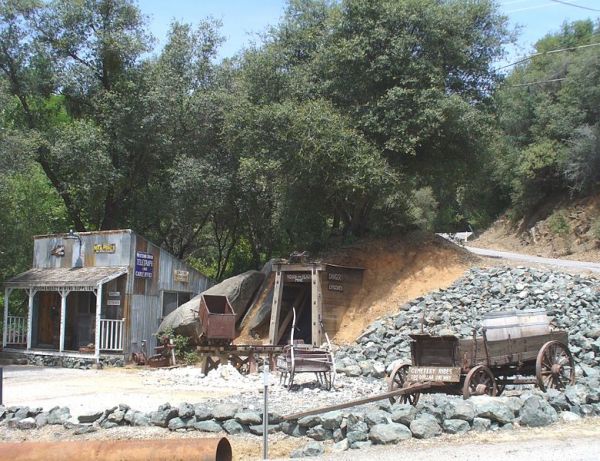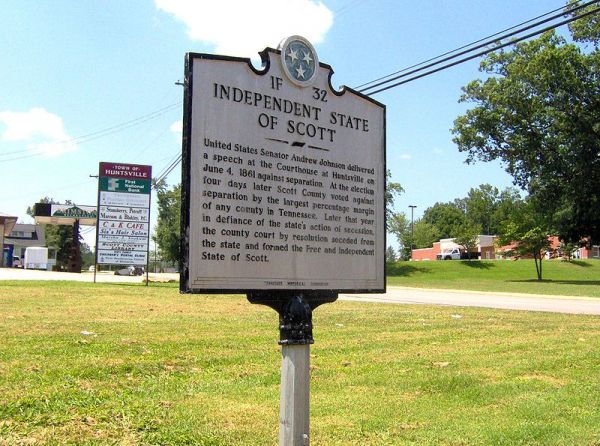The War Between the States was sparked when eleven states tried to secede
from the Union. They’re not the only ones. Here are
some other lesser-known secessionist movements.
1. THE GREAT REPUBLIC OF ROUGH AND READY
 Seceded from:
Seceded from: The United States, in April 1850
Details:
At least two reasons have been cited for why the tiny mining town of
Rough and Ready, in California’s gold country, decided to secede from
the Union. One was anger over the imposition of a tax on mining claims,
and the other involved a man known as the “Boston Ravine Slicker,” who
swindled a popular miner named Joe Swiegart out of $ 200. When a local
judge refused to prosecute the Slicker on the grounds that he hadn’t
actually broken any laws, Rough and Ready seceded from the United States
and “the next morning rescued what was left of Joe’s money and took the
Slicker to the edge of town with instructions never to return,” writes
Fay Dunbar of the Nevada County Historical Society. (Another version of
the story says the Slicker was hanged.)
What Happened:
Whatever the case, the Great Republic of Rough and Ready voted to
rejoin the Union in time to celebrate the 4th of July, perhaps hurried
along by the refusal of saloons in nearby Nevada City and Grass Valley
to sell liquor to Rough and Ready’s “foreign miners.”
2. THE FREE AND INDEPENDENT STATE OF SCOTT
Seceded from: Tennessee, in June 1861
Details:
Tennessee was divided over whether to secede from the Union and was the
last state to do so, about two months after the Civil War started. The
citizens of Scott County, in northeastern Tennessee, voted against
secession by the greatest margin of any county in the state. When
Tennessee left the Union, the Scott County Assembly voted to leave
Tennessee. A messenger was sent to Nashville to inform the state that
the county was “henceforth to be known as the Free and Independent State
of Scott.”
What Happened: Not much—
Scott County was of little strategic value to either the Union or the
Confederacy. Both sides ignored the secession, and no major Civil War
battles were fought there. But Scott County didn’t formally rejoin the
state until 1986, when Governor Lamar Alexander signed a resolution
declaring the State of Scott “dissolved and disbanded… after 125 years
of independence.”
3. THE REPUBLIC OF KINNEY
Seceded from: The United States, in July 1977
 Details:
Details:
When the water system in Kinney, Minnesota, began to fail in the
mid-1970s, the village of 325 people couldn’t afford the $186,000 price
tag to replace it. And when it applied for funding from various state
and federal agencies, the request got bogged down in red tape. So in
July 1977, perhaps inspired by the 1959 film
The Mouse that Roared,
the village council announced their intention to secede from the U.S.
and apply for foreign aid. “It is much easier to get assistance as a
foreign country, which we need badly, and there is no paperwork to worry
about,” the council wrote in a letter to Secretary of State Cyrus
Vance, adding that “if necessary, we will be glad to declare war and
lose. However, if this is a requirement, we would appreciate being able
to surrender real quick, as our Mayor works as a nurse in a hospital,
and most of our council members work in a nearby mine and cannot get
much time off from work.”
What Happened: The publicity stunt landed Kinney on the
NBC Nightly News
and helped it do a brisk business in Republic of Kinney “passports,”
T-shirts, bumper stickers, and other items. But it didn’t speed up the
bureaucratic process much: The funding for their water system didn’t
come through until November 1978.
4. WENDOVER, UTAH
Attempted to Secede from: Utah, in 2002
 Details:
Details: Wendover
makes up half of the metropolitan area that it shares with West
Wendover, across the state line in Nevada. The difference between the
two cites is stark: West Wendover’s economy is buoyed by Nevada’s
legalized gambling and its casinos attract nearly two million visitors
each year. Wendover, by comparison, is a veritable ghost town, thanks to
no gambling, and some of the strictest state liquor laws in the
country. Allowing Wendover to leave Utah and join West Wendover in
Nevada would give its struggling economy a boost and allow the cities to
combine police and fire departments and other public services that are
needlessly duplicated. The citizens of both cities approved the
secession/ annexation in a nonbinding referendum in November 2002.
What Happened:
In order for a city to leave one state and join another, the U.S.
Constitution requires that the legislatures of both states and the U.S.
Congress approve the move. The first constitutional hurdle was passed in
2002, when the U.S. House of Representatives unanimously approved a
bill permitting succession. But the bill died in the Senate, thanks to
opposition from Senator Harry Reid of Nevada, who never gave a reason
for why he killed the bill.
5. KILLINGTON, VERMONT
Attempted to Secede from: Vermont, in 2004
 Details:
Details: This
upscale resort town is home to the Mt. Killington ski area. When
Vermont changed the way it pays for public education in 1997, creating a
statewide pool of funds to replace the old system of local funding,
towns like Killington with high-priced vacation homes and few schools
saw their property taxes quadruple. Property taxes in next-door New
Hampshire were lower, and there was no state sales tax or income tax,
either. Suddenly being in Vermont didn’t seem very attractive. At packed
town meetings in 2004 and ’05, the residents voted overwhelmingly to
secede from the state and join New Hampshire.
What Happened:
Killington is still part of Vermont, and probably always will be. For
one thing, unlike Wendover, Utah, which is right on the border,
Killington is smack in the middle of the state, 35 miles from the New
Hampshire line. Attempts to create a “corridor” of secessionist towns
all the way to the border have failed. And the state of Vermont, which
must approve secession, has shown no signs of being willing to do so. In
2005, three state legislators introduced legislation to slap Killington
with crippling “exit fees” if it ever did leave the state. So in 2006,
the town abandoned its plans for secession… but it’s still lobbying to
change the property tax laws.









